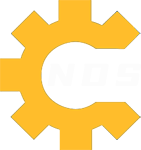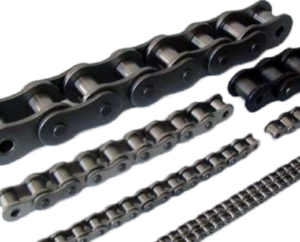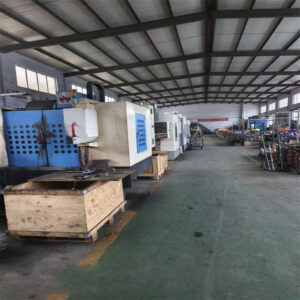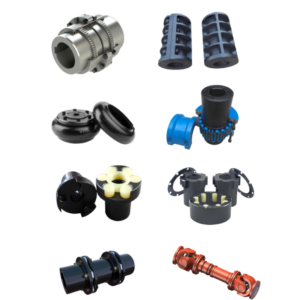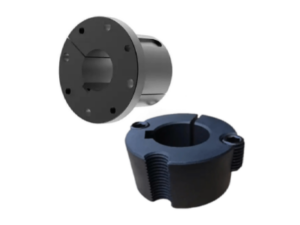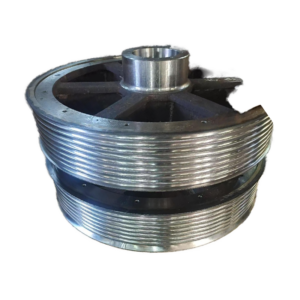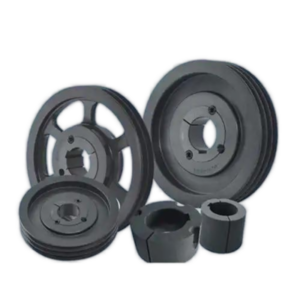Industrial chains are diverse and widely used. Their models are primarily classified based on purpose, structure, standards, and dimensions. Below are the most common and important categories of industrial chain models and their representative series:
1. Transmission Roller Chains
This is the most widely used and fundamental type of industrial chain, mainly for power transmission.
- Standard Roller Chain (A Series)
- International Standard (ISO 606): Typically denoted by number + letter B.
- Common Models:
04B,05B,06B,08B,10B,12B,16B,20B,24B,28B,32B,40B, etc. - Chinese Standard (GB/T 1243): Corresponds to the international B series, with the same model designation (
08B,16B, etc.) or older standards usingTGprefix (e.g.,TG127corresponds to08B). - Characteristics: Single strand, classic structure, most common application. Larger numbers indicate larger chain dimensions (pitch) and higher load capacity (e.g.,
08Bis larger than06B).
- Heavy Series Roller Chain (B Series / ANSI Series)
- American Standard (ASME B29.1): Typically denoted by a number (without letter B).
- Common Models:
35,40,50,60,80,100,120,140,160,180,200,240, etc. - Characteristics: Compared to the standard B series (ISO), chains with the same pitch have larger roller diameters, thicker and taller link plates, resulting in higher tensile strength and better wear resistance. For example,
40has the same pitch as08B(1/2 inch) but higher strength. Often used for transmissions requiring higher loads or harsher conditions.
- Multi-Strand Roller Chain
- Model Designation: Adds
-numberto the single-strand model to indicate the number of strands. - Common Models:
08B-2,10B-2,12B-3,16B-4,40-2,50-3,60-4, etc. - Characteristics: Composed of 2, 3, or 4 single-strand chains assembled side-by-side with extended pins. Multiplies the chain’s load capacity without significantly increasing sprocket width. Very common in medium to high-power transmissions.
- Model Designation: Adds
2. Conveyor Roller Chains
Specifically designed for material conveying equipment, emphasizing load-bearing capacity, wear resistance, impact resistance, and lateral rigidity.
- Straight Side Plate Conveyor Chain
- International Standard (ISO 1977 / ISO 4348): Often starts with letter
AorB, followed by numbers. - Common Models:
ASeries (e.g.,A2080– Pitch 2.5 inches),BSeries (e.g.,B2080– Pitch 2.5 inches). Numbers typically represent pitch (inches*100) and link plate form code. - Chinese Standard (GB/T 8350): Commonly uses
SorCseries (e.g.,S50– Pitch 50.8mm ≈2 inches,C2060– Pitch 38.1mm ≈1.5 inches). - Characteristics: Pins are riveted at both ends, straight link plates, robust structure, general-purpose conveyor chain.
- International Standard (ISO 1977 / ISO 4348): Often starts with letter
- Hollow Pin Conveyor Chain
- Models: Often designated by adding
HorHPto the straight plate chain model (e.g.,A2080H,S50-HP). - Characteristics: Pins have a central hole, allowing bolts, pins, or other attachments to be fixed to the pin for mounting conveying slats, flights, buckets, etc. The core chain type for conveyor lines.
- Models: Often designated by adding
- Side Flexing Conveyor Chain
- Models: Vary by manufacturer (e.g.,
LFseries,FBseries,SXseries), but clearly specify pitch and side flexing capability (e.g.,LF400– Pitch 38.1mm, min. bending radius R~600mm). - Characteristics: Specially designed link plates (often figure-8 shaped) allow the chain to bend in the horizontal plane, used for curved conveyor lines. Often available in hollow pin versions for attaching accessories.
- Models: Vary by manufacturer (e.g.,
- Engineered Steel Chain
- Models: Diverse structures; models usually include pitch, roller type, link plate form (e.g.,
EWtype – large roller on outer links,ERtype – large roller between inner and outer links). - Characteristics: Heavier, more robust construction, larger rollers (often bushed rollers), extremely high load capacity, wear resistance, and impact resistance. Used for heavy-duty, low-speed, harsh applications (e.g., metallurgy, mining, wood processing).
- Models: Diverse structures; models usually include pitch, roller type, link plate form (e.g.,
3. Leaf Chain / Lifting Chain
- International Standard (ISO 4347): Often starts with
LHfollowed by numbers (e.g.,LH0822,LH1224). - Chinese Standard (GB/T 6074): Commonly uses
LTseries (e.g.,LT20). - Characteristics: Composed of stacked link plates (no rollers) connected by pins. Compact structure, very high tensile strength, but can only withstand pure tension (poor flexibility). Designed specifically for vertical lifting and pulling, core component in forklift mast systems and hydraulic lifting platforms. Numbers in the model typically indicate the link plate configuration (number of inner plates x number of outer plates) and width.
4. Silent Chain / Inverted Tooth Chain
- Models: Vary by manufacturer, usually include pitch and width (e.g.,
SC3-50– Pitch 9.525mm, Width 50mm). - Characteristics: Consists of multiple toothed link plates meshed together via pins. Works by meshing with the sprocket rather than friction, resulting in very low noise, smooth transmission, and suitability for high speeds. Used where low noise and smoothness are critical (e.g., automotive engine timing systems, precision machine tool drives).
5. Other Specialized Chains
- Agricultural Chain: Structure similar to roller chain, but often with special attachments (e.g., flights) or coatings (anti-mud/water corrosion), used in harvesters and other farm machinery. Models like
CA550,S67, etc. - Stainless Steel Chain: Made of 304, 316 stainless steel for corrosion-resistant, hygienic environments (e.g., food, pharmaceutical, chemical). Can be material variants of drive, conveyor, or leaf chains.
- Nickel/Teflon Coated Chain: Special surface treatments for enhanced corrosion resistance, wear resistance, self-lubrication, or non-stick properties.
- Top Plate Chain / Flat Top Chain: Chain links have wide plastic or metal top plates for direct conveying of bottles and cans (e.g., filling lines).
- Forged Chain: Links are forged, extremely robust and wear-resistant, used for extreme heavy-duty and impact applications (e.g., ship anchor chains, large crane chains).
Key Parameters for Chain Model Selection
- Pitch: Distance between adjacent pin centers, determines sprocket tooth count and chain size.
- Strand Number: Single, Double, Triple, Quadruple.
- Roller Diameter/Type: Standard roller, large roller, no roller (bush chain).
- Link Plate Thickness/Height: Affects strength.
- Inner Width/Outer Width: Affects meshing with sprockets and installation space.
- Minimum Tensile Strength: Maximum static tension the chain can withstand.
- Attachment Type: Crucial for conveyor chains (e.g., K-type, M-type attachments).
- Material: Carbon steel, alloy steel, stainless steel, etc.
- Surface Treatment: Black oxide, galvanized, nickel-plated, etc.
Important Notes
- Prioritize Standards: Whenever possible, choose chains conforming to international (ISO), national (GB, ANSI), or industry standards to ensure interchangeability and reliability.
- Match Application Conditions: Model selection must strictly consider actual application conditions: load (magnitude, type – static/dynamic/impact), speed, environment (temperature, humidity, dust, corrosives), lubrication conditions, space constraints, etc.
- Consult Manufacturers: For complex or critical applications, always refer to the chain manufacturer’s product catalogs, selection guides, or consult their technical support directly. Different manufacturers may have specific optimized series or models.
- Safety Factor: Determine an adequate safety factor during selection based on conditions (Working Load / Minimum Tensile Strength).
The models listed above are representative categories and series. In practice, a specific chain model will include more detailed information (e.g., pitch, strands, attachment type, material, surface treatment). Always perform precise selection based on equipment requirements and manufacturer documentation.
